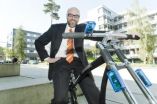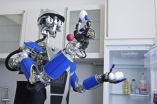(Press-News.org) At this time, wireless networks are able to brake just one bike, but in the future, the technical elements will be further developed to regulate entire trains as they travel over the lines. In view of that fact, computer scientists at Saarland University are designing mathematical calculations to check such systems automatically. The scientists will present their results at stand F34 in hall 26 at the computer fair Cebit. The trade show takes place in Hanover, Germany from March 6 to 10.
Professor Holger Hermanns, who holds the chair of Dependable Systems and Software, and who developed the wireless bicycle brake together with his group, explains: "Wireless networks are never a fail-safe method. That's a fact that's based on a technological background." Nonetheless, the trend is to set up wireless systems that, like a simple bicycle brake, have to function all the time. "In the field of the future European Train Service, for example, concrete plans already exist," Hermanns reports. Furthermore, he says that train and airplane experiments are far too sophisticated, and could even endanger the life of human beings in case of malfunction.
Therefore, the Saarland computer scientist's mathematical methods should now verify the correct function and interaction of the components automatically. "The wireless bicycle brake gives us the necessary playground to optimize these methods for operation in much more complex systems," Hermanns adds. Therefore, his research group examines the brake prototype with algorithms that normally are used in control systems for aircraft or chemical factories. As a result, they found out that the brake works with 99.9999999999997 percent reliability. "This implies that out of a trillion braking attempts, we have three failures," Hermanns explains and concludes: "That is not perfect, but acceptable."
To brake with the wireless brake, a cyclist needs only clench the rubber grip on the right handle. The more tightly the grip is clenched, the harder the disk brake on the front wheel works. It seems as if a ghost hand is in play, but a combination of several electronic components enables the braking. Integrated in the rubber grip is a pressure sensor, which activates a sender if a specified pressure threshold is crossed. The sender is integrated in a blue plastic box which is the size of a cigarette packet and is attached to the handlebar. Its radio signals are sent to a receiver attached at the end of the bicycle's fork. The receiver forwards the signal to an actuator, transforming the radio signal into the mechanical power by which the disk brake is activated. The electrical energy is supplied by a battery, which is also attached to the bicycle's fork. To enhance reliability, there are additional senders attached to the bicycle. These repeatedly send the same signal.
Its current configuration enables the cruiser bike to brake within 250 milliseconds. This means that at a speed of 30 kilometers per hour, the cyclist has to react two meters before reaching the dangerous situation. But the Saarland University computer scientists are not satisfied with just this functionality. "It is not difficult to integrate an anti-lock braking system and traction control. That takes only a few adjustments," Hermanns explains.
Researching the wireless bicycle brake was funded within the special research field "Automatic Verification and Analysis of Complex Systems (AVACS)" by the German Research Foundation. Besides Holger Hermanns, several researchers from Saarland University are involved. These are Professors Sebastian Hack, Markus Bläser, Reinhard Wilhelm, Jan Reineke, Bernd Finkbeiner and Verena Wolf. Professor Kurt Mehlhorn and Christoph Weidenbach of the Max-Planck-Institute for Informatics in Saarbrücken are involved in the project, too. In 2011, the Research Foundation Group approved about 8.7 million euro, and about 3.5 million inure to the benefit of the Saarland research work. Since 2004, the special research group has been sponsored with approximately 26 million euros, and 9.5 million went to the computer scientists at Saarland University.
INFORMATION:
See also:
- A Verified Wireless Safety Critical Hard Real-Time Design
http://www.mpi-sws.org/~vahldiek/papers/wowmom.pdf
- AVACS
http://www.avacs.org/
- Chair of Dependable Systems and Software
http://depend.cs.uni-saarland.de
Cebit 2012: The wireless bicycle brake, a prototype on an exciting mission
2012-02-27
ELSE PRESS RELEASES FROM THIS DATE:
Will 2012 Prove to be Yet Another Record Breaking Year for Popular Thai Tourist Resort, Krabi?
2012-02-27
The beautiful province of Krabi in south west Thailand enjoyed a remarkable year in 2011, with a record number of tourists visiting the area, despite a devastating flood which severely impacted the Thai tourist trade. Amazingly in 2012, Krabi villas, hotels and resorts are already reporting an improvement on last years impressive performance, even factoring in a traditionally busy period covering Chinese New Year.
Since the very beginning of the year, we have been experiencing our highest occupancy rates ever, Ton Loriers, managing director at Krabi Villas by Ton Company ...
Novel method to make nanomaterials discovered
2012-02-27
Researchers at the NanoScience Center of the University of Jyväskylä, Finland, and at Harvard University, US, have discovered a novel way to make nanomaterials. Using computer simulations, the researchers have been able to predict that long and narrow graphene nanoribbons can be rolled into carbon nanotubes by means of twisting. The research has received funding from the Academy of Finland.
The basic idea is simple and easily explained: just twist the ends of a strap on your backpack and watch what happens. Being classical in origin, the mechanism is robust and valid ...
CeBIT: Robot obeys commands and gestures
2012-02-27
At the CeBIT in Hanover, Karlsruhe Institute of Technology and the FZI Research Center for Information Technology will present innovations for our everyday life in the future. At the joint stand G33 in hall 26, a humanoid kitchen robot will move around, three-dimensional visualizations will open up new perspectives, and new algorithms will be presented to protect data in the cloud. The FZI House of Living Labs will present the interactive HoLLiE service robot and solutions for intelligent energy management.
ARMAR Robot Learns by Watching
A robot helping in the household ...
A study describes liquid water diffusion at molecular level
2012-02-27
An article published in Physical Review and conducted by researchers at the universities of Granada and Barcelona might lead to a revolutionary change in water desalination and filtration methods.
Researchers at the universities of Granada and Barcelona have described for the first time the diffusion of liquid water through nanochannels in molecular terms; nanochannels are extremely tiny channels with a diameter of 1-100 nanometers that scientists use to study the behavior of molecules (nm. a unit of length in the metric system equal to one billionth of a meter that is ...
92 percent of families with adopted children are satisfied with their decision
2012-02-27
Two separate surveys six years apart have been used to analyse the level of satisfaction with adoptions in Andalucía. The study shows that 77.7% of families are happier after the process and variables that make it more difficult have been identified, such as the age of the children when arriving, multiple adoption and previous experiences of abuse. There is a significant link between the parents' assessment and that of the children.
"We wanted to know to what extent adoptions in Spain are providing children who need it with a healthy family environment that promotes their ...
A new radiotherapy technique significantly reduces irradiation of healthy tissue
2012-02-27
Researchers at the University of Granada and the university hospital Virgen de las Nieves in Granada have developed a new radiotherapy technique that is much less toxic than that traditionally used and only targets cancerous tissue.
This new protocol provides a less invasive but equally efficient cancer postoperative treatment for cases of cancer of the oral cavity and pharynx.
The study -conducted between 2005 and 2008- included 80 patients diagnosed with epidermoid cancer of the oral cavity and pharynx, who had undergone lymph node removal. The affected nodes were ...
Top Performing Internet Marketers to Hold Exclusive Legacy Event
2012-02-27
Well-known internet marketers, Aaron and Sophia Rashkin along with members of the Loyal 9 Revolution have scheduled the "Legacy" on March 24 and 25, at the offices of the Loyal 9 in New Jersey.
The Legacy is an extremely focused event and follows the AFL Freedom Mastermind 2 that took place in late January at the Rashkin home office in beautiful Parker, Colorado. That 2 and 1/2 day live training experience brought together 12 inspired entrepreneurs from around the world to teach them the mindset and the successful internet marketing strategies used by these ...
Study IDs new marine protected areas in Madagascar
2012-02-27
NEW YORK (February 24, 2012) – A new study by the University of California, Berkeley, Wildlife Conservation Society, and others uses a new scientific methodology for establishing marine protected areas in Madagascar that offers a "diversified portfolio" of management options – from strict no-take zones to areas that would allow fishing.
The methodology looks at existing information on the country's climate, along with dependence on fisheries and marine resources, and applies three different planning approaches to establish priorities for management along the entirety of ...
Protecting the climate by reducing fluorinated greenhouse gas emissions
2012-02-27
Hydrofluorocarbons (HFCs), which have been used in recent years in increasing quantities as substitutes for CFCs, are also climatically very active and many are also extremely long-lived. In the renowned journal Science an international team of researchers recommends that the most potent of these gases also be regulated. This could save the positive «side effect» of the Montreal Protocol for the global climate.
It is regarded as the most successful international environmental agreement and has, to date, been ratified by 196 countries – the Montreal Protocol on Substances ...
Experts in pediatric heart disease present research at Cardiology 2012 conference
2012-02-27
Pediatric cardiology researchers and clinicians from almost 50 centers from across the U.S. and around the world are gathering at the Cardiology 2012 Conference sponsored by The Children's Hospital of Philadelphia on Feb. 22-26 in Orlando, Fla. The news briefs below summarize 11 research abstracts selected by the conference organizers as featured presentations. The researchers leading these presentations comprise 6 physicians and 5 nurses.
New Early Warning Algorithm Detects Children's Early Cardiac Deterioration Before Inpatient Arrest
Most cardiopulmonary arrests in ...





